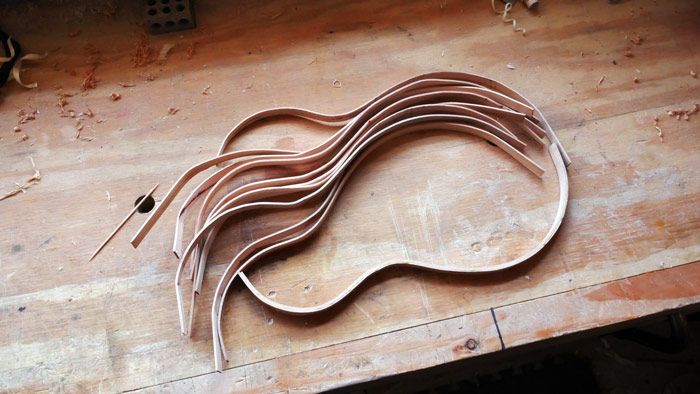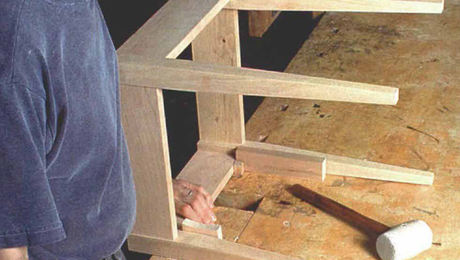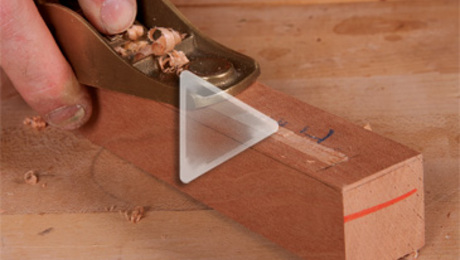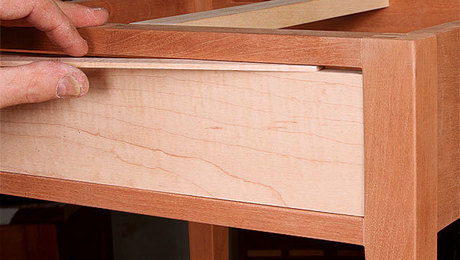Editor’s letter: The fear of failure
Ben Strano argues that you'll become a better woodworker when you accept and expect that mistakes will happen.
Before me sits a pile of fail pieces. Attempts at making wood bend in precise ways it didn’t want to bend. I’m not bothered one bit by this pile. I’ve been trying to figure out why it’s not bothering me. Years past, I’d have been annoyed by every single one of these pieces not turning out the way that I wanted them to. Each one would have made me feel discouraged, then frustrated, then likely I would have abandoned the project altogether.
This job gives me a glimpse behind the curtain. I’ve seen woodworkers that I have looked up to for years–straight up—screw up. They all do. I’ve seen mistakes made by Mike Pekovich, Chris Becksvoort, Bob Van Dyke, Tim Rousseau, Chris Gochnour … let’s just say I’ve seen some mistakes made by them all. The difference is, they do it with style. They deal with it, and they move on. When you’re learning how to work wood–by yourself in your shop–you can only take in the information that’s given to you. Most of the time, you see the end product. Whether it’s the product of fancy video editing, or the product of countless iterations and prototypes, you are seeing the end product. Stop judging yourself, your skills, or your project on other people’s end products. Trust me, you’re not seeing the repetition. You’re not seeing all that has gone into a piece. You can’t.
I no longer assign value to my woodworking skills based on my current or past projects. For me, woodworking is a journey. Once I stopped thinking that every project had to be perfect, I got better and better because my attitude got better. I was able to try things and not worry about their outcome. I was able to move forward with a project even though it was flawed. You don’t get better by stopping.
My projects have flaws. They will always have flaws. But, every time I screw up, it’s one more notch on the wall, one more “point” earned, one more mistake that I can stop worrying about. They are all there for the taking. Until you make the mistake, and learn from the mistake, it’s just waiting for you to stumble upon it.
If I make a new mistake, I’d better find a way to learn from it. Why did it happen? How can I set myself up to make sure it doesn’t happen next time? Do I need to use a different tool or technique? Did I not inspect my material properly? Did I mark my piece properly? Etc. etc.
If it’s an old mistake that has reared its head again, I know how to fix it. It’s not nearly as daunting the second time around. Laugh it off, suck it up, and fix it.
When I look at the pile of failed bends in front of me, I see notches on the wall. Whether it was a change to a bending form, more time in the steambox, or better clamping techniques, I learned from every single one of them, getting me closer to my final goal. From the moment I cut into the board, I knew these pieces were not do or die. I milled up extra stock because I knew I was going to try some new techniques and rack up some “mistake points.” I knew that I would find success in a good bend, or a bad bend.
Accept that you’re going to make mistakes. They are not novel. Learn to glory in them, because that’s the only way they are worth it.
 |
When Mistakes Happen |
 |
Fixing Woodworking Mistakes |
 |
How to Fix Flaws and Mistakes |






















Comments
Here here! Such a good article. I look at it this way: It's not a mistake - it's character! The beauty of woodworking and building things one at a time, is that each one is unique and beautiful. I am just as proud of the work I did 30+ years ago, as I am the work I did 3 days ago.
This is timeless advice. I look back on some of the things that have happened and I can only laugh now. But at the time, it all seemed pretty traumatic. I've cut furniture pieces from beautiful wood and gone to lunch and returned an hour later only to find them warped. And the moisture content was perfect when I started. I've milled pieces and was so happy to see how great they were only to trip with them in my hand and watch them self destruct on the floor. I've cut tongue and groove joints by machine and by hand and have had numerous instances, AFTER FINAL SANDING, where the darn edge of one of the grooved pieces cracked. There have been times I felt I needed Holy Water and a priest on standby as I finished a project. This doesn't even begin to include the inexplicable when it comes to finishes. Thank you Ben.
Just finished a Fine Woodworking / Mike Pekovich Arched Entry Table in Mahogany this morning, then happened to catch your "The fear of failure"
piece. Made me laugh out load. Building the table afforded me plenty of (shall we say), learning experiences. The cursing eventually turned to laughter and then the realization that I actually enjoyed the necessary problem solving, and it's resulting sense of accomplishment.
Keep up the great work Ben
Cosigned.
"If a thing is worth doing, it is worth doing badly." - G.K. Chesterton
Nice article, Ben! I agree and get mad at myself everytime! Thanks for the great advice and great work on the magazine, website and podcast! Darwin
In the mid 1970's when I was an apprentice carpenter, one (or more) of the journeymen I worked with taught me two things about mistakes;
If you're not making any mistakes, you're not doing anything.
and
Anybody can make a mistake, professionals know how to fix them.
Do you remember the business and project management theorist mantra of a decade or so ago: "RIght first time"? That always made me laugh. Well, not always as many business and project management domains took this nonsense literally and insisted everything really was right first time. As this is impossible in most activities, a faulting fellow would hide his mistakes or pretend they weren't there. Consequent business or project crumble would then ensue.
****
Perhaps the trick is to try and make the inevitable but instructive mistakes in the right way and at the right time. Doing so on a near finished complex part is not a good experience if it mean starting that whole part from scratch. It pays to practice on a scrap bit first. But how often have you made yourself hurry, so performed a fatal error on the part you've already spent several man days on.....
There are mistakes in technique and meta-mistakes in design and overall process. The latter are the rascals to be most wary off.
Lataxe
Here here!
The above advice combined with 'Learn what sharp really means' are the two pieces of advice that have advanced my woodwork most.
Cheers Ben!
So true. My skills and results took a giant leap when I realized that:
- There will be waste product.
- You will mess up; it can be the material, the supplies, inattention or just that you need more skill-building.
- It is better to 'make another one' than to do a poor repair on the one you messed up.
It speaks to how important woodworking is to me that when I experience a failure in the shop, I take a deep breath and calmly go about the business of dealing with it. In other parts of my life I do not deal with failures quite so well ;-)
When I am not working in my shop I am working with my honey bees. An old beekeeper told me once, that some people keep bees for 25 years and learn something new every year, others keep bees for 25 years and really just kept doing the same thing and making the same mistakes every year for 25 years. So they were not really any more experienced or knowledgeable than their first year. The key is to try new things and make new mistakes, try to avoid repeating the same old ones over and over.
I've cut this board 3 times and it's still too short........
Excellent writing Ben. It is great to see such quality work.
In their 1993 book "Art and Fear; An Artist's Survival Guide" David Bayles and Ted Orland concluded with this:
"In the end it all comes down to this: you have a choice (or more accurately a rolling tangle of choices) between giving your work your best shot and risking that it will not make you happy, or not giving it your best shot--and thereby guaranteeing that it will not make you happy. It becomes a choice between certainty and uncertainty. And curiously, uncertainty is the comforting choice."
See also:
--Nothing ventured, nothing gained
--Paralysis by analysis
--From Wendell Castle's 10 Adopted Rules of Thumb:
#5 "The dog that stays on the porch will find no bones."
#10 "If you hit the bulls-eye every time the target is too near."
How about an alternative view? Well, not exactly an alternative but a different perspective....
A great part of ridding complex practices of fear of failure is the getting rid of the fear - paradoxically by failing quite often and getting used to it; and learning from it. But some kinds of failure can be fatal - fatal to the practitioner or (more likely) fatal to his or her desire to perform the practice.
Some failures are catastrophic. For example, early in an attempt to learn cycle racing you can push the envelope so hard it rips badly. You have a serious crash, get badly damaged physically but also suffer such a blow to your confidence that it never recovers. (And maybe your hip got so crushed it doesn't either, at least not for cycle racing). I've seen this sort of catastrophic failure more than once, with no return of the failed-one to the bike racing!
In activities like woodworking there are the fatal errors of the cut-off-my-hand type (and associated loss of confidence with all woodworking things afterwards) but also the mental blows fatal to the desire to continue with a complex practice like woodworking. I've seen would-be woodworkers who plunge in only to make horrible bodge after serious scrap-it mistake such that they become utterly disheartened. Perhaps they do it twice and .... that's the end.
The problem is usually ignorance: a rush that allows no time for any theory; a stubborn refusal to change the approach that relies on a crude "I can beat it" (they can't) to one more appropriate to the novice. Some people have come to believe that all they need to do to become something is to stick a label on themselves that says they are a whatever. Or buy all the equipment and the apron. All the gear but no idea (and never will have - they have the badge, see)!
So much depends on the frame of mind in which you begin to learn a skill. Many men, in particular, need first to learn the aphorism: RTFM! Many believe that "I don't need no steenkin' manual". Of course, they do. Many believe they can buy their way to being a woodworker via tool acquisition. They can't.
**********
A good teacher or mentor (as another FWW article hereabouts explains) makes such a difference. Starting out knowing that mistakes are a learning opportunity (and believing that learning is not just for the little kids) are essential. So is a basic degree of care and caution, if one is to avoid some form of crash (to the ego) and burn (of the willpower). A guide for the would-be traveller through the seeming jungle of ideas and skills associated with any complex practice is such a huge help.
Personally I had FWW and Knots.
Lataxe
Thank you, Ben, for the encouraging message. The single biggest hurdle I have in becoming a better craftsman is developing a better attitude about the mistakes I make. You are “spot on” in the way you describe the way you deal with mistakes and failures.
Andy
I have made most of the mistakes, and learned to repair them. But lately i have been leaving them. It's not that i don't care, it's just not going to make the product enough better to warrant the time. Besides, it's man made. As a corrupted human, i tend to made slightly corrupted stuff.
Thank you Mr. Strano for this wonderful advice. I love the idea of woodworking, but have difficulty actually doing any, for fear of not doing it well enough. It is ridiculous, but apparently not unusual. Your essay is just what I have needed; may it be so for others. Thank you again.
A timely read for me. I work alone and this afternoon was finishing up the base for Mike's and Matt's work bench that I have been working on foe two weeks. I had it upside down on my outfeed table as I didn't like the idea of fitting the second end at head height, trying to match three tenons with three mortices plus guide the boards of the end panel into the groove on the back leg. Everything went well, I got the front rail in at both ends, and the back leg went on nicely. got it all glued up, clamped, and perfectly square. As I started to put in the first pin for draw boring I suddenly realized I could see right through it-after dry fitting it a couple of days ago I had also removed the boards of the panel and forgotten to put them back in after making a couple of adjustments. Fortunately the glue hadn't completely set up and I was able to pound it apart and get them in. It didn't go back together as easily and it is an eighth out of square. Considering what might have been I can live with that. If I hadn't been so lucky I might have regressed 20 years in my "don't mater so much" campaign.
Log in or create an account to post a comment.
Sign up Log in